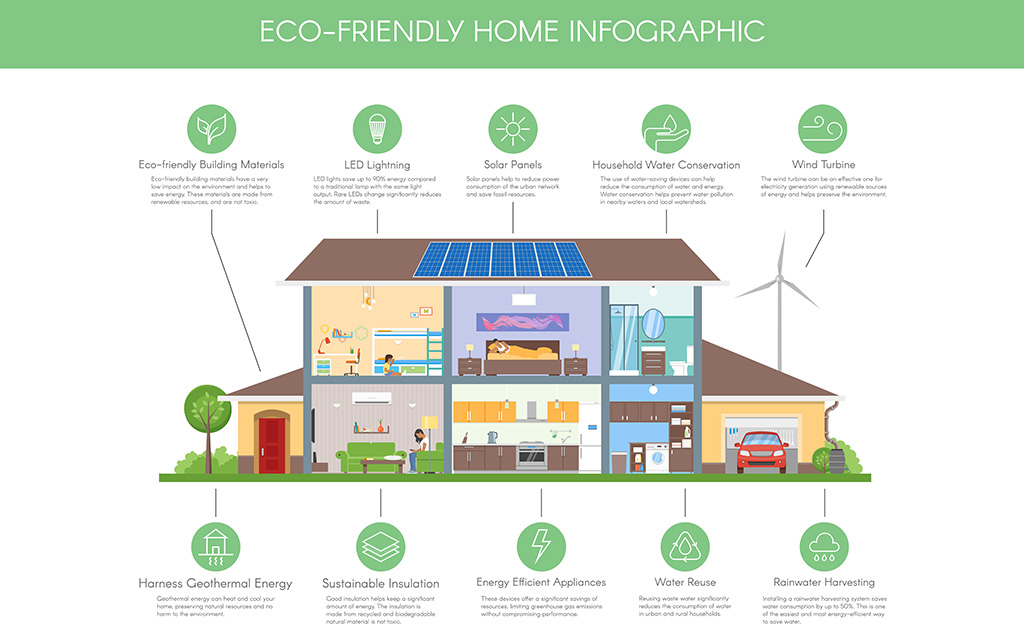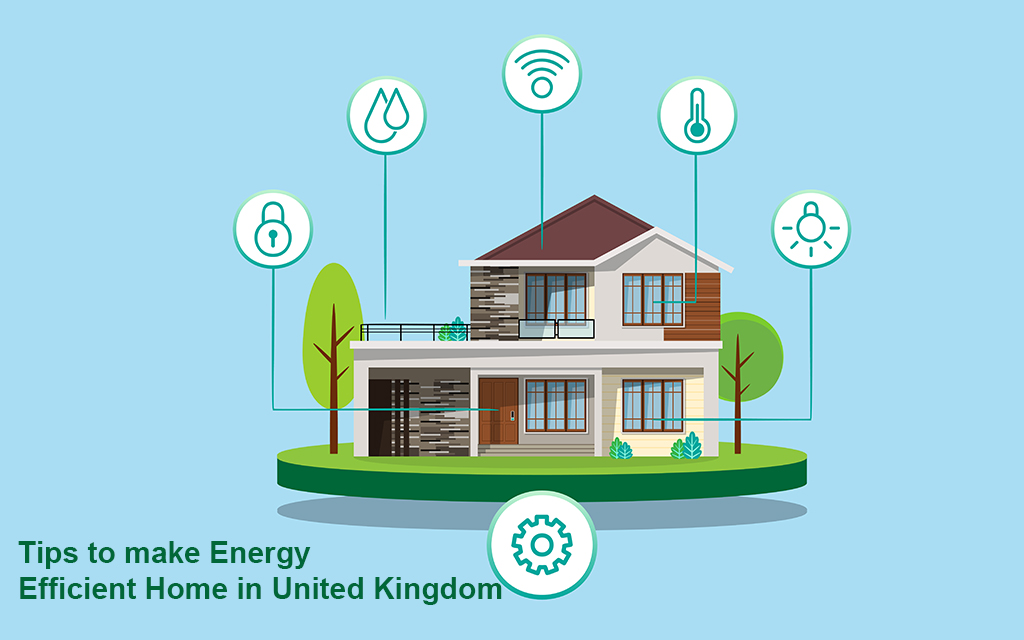Every term of energy saved counts!
This statement is more relevant today than ever before. With the need to tackle the climate emergency, addressing fuel poverty concerns, and dealing with the growing energy crisis, making our homes more energy-efficient has become a necessity.
The United Kingdom has set ambitious goals such as achieving NetZero by 2050 to reduce carbon emissions and boosting energy efficiency.
Homeowners can play a significant role in achieving them by playing their part in saving environment.
Learn the quick ways to make your home more energy-efficient and reduce the carbon footprint. Also, learn the government grants available and get a checklist to know how energy efficient your home is.
What do you mean by energy efficient homes or low carbon homes? And why is this on high priority?
Energy-efficient or low carbon homes are designed to reduce the amount of energy consumed and the carbon emissions associated with the building, making them more environmentally friendly and sustainable.
The benefits of these eco friendly homes UK include:
- Warm and soothing internal ambience
- Good indoor air quality
- Reduced environmental impact
- Excellent ventilation
- Low Energy bills
- Reduced carbon footprint
- Gas-free homes (safer and greener)
So, how it can be done? It’s covered in the next section. Don’t forget to check how energy efficient is my home and other government grants that are being given by the UK government for aiding energy efficient homes.
Quick and Easy Tips for Energy Efficient Homes And Require No Investment

Here are some quick and easy tips for making your home more energy-efficient without requiring any investment:
Be smart and use an app to track your energy consumption
Most of us have a smart meter for tracking energy usage. There are many apps available in the digital marketplace which are free and helps you track your energy consumption in weeks, days, months or years.
This will enable better understanding of your energy consumption and finding perfect ways to reduce the utilisation and save a huge on energy bills in a pretty safe and manageable way.
You can search for smart meter apps on your browser or marketplace and download the best suited one.
Closing Your Blinds and Curtains at Night
Want to save on heating costs in an easy and free way? Close your curtains and blinds at night. It can prevent warm air from escaping.
Especially useful if you have radiators under your windows. This’ll keep your home warm and cosy during colder months.
By minimizing Tumble trying option for clothes
Tumble dryers are known to consume a lot of energy. In fact, they are the most energy-intensive appliances in a household.
However, their usage can be reduced by ensuring that the dryer is used with a full load, three-quarters of the drum capacity.
In addition, drying clothes outside or inside with an open window for ventilation on a clothes airer is a wonderful way to save energy.
It’s important to avoid overfilling the dryer, as this can lengthen the drying time and increase energy consumption.
Washing clothes at lower temperatures
Washing clothes at a lower temperature can be an effective way to save energy. With modern washing machines, clothes can still be cleaned effectively at lower temperatures.
Switching from 40°C to 30°C can help increase the number of cycles you get from the same amount of energy, potentially allowing for three cycles instead of two, depending on your washing machine.
This small adjustment can make a significant difference in reducing energy consumption and lowering your utility bill.
Unplugging or turning off the socket when not in Use
When electrical appliances like laptops, desktops, televisions, smart devices, and video game consoles are not in use, they still consume power continuously.
To lower energy consumption and decrease utility costs, it is crucial to turn off the power switch at the socket or unplug the appliances.
By following this basic step, one can avoid standby power consumption that can accumulate to a substantial amount of energy wasted over time.
Decreasing the flow temperature of the radiator in combi boiler
Flow temperature in boiler is that temperature in which the water flows to the radiators.
This flow temperature actually doesn’t impact the temperature of the room nor does it has anything related to temperature of the thermostat.
By keeping the flow temperature down to 60 degree will just increase the time it takes to reach the set temperature on the thermostat. It helps you save a lot on your savings and energy bills.
Keep doors and windows closed
By keeping doors and windows closed helps keep the heat in during the winters and the cool air in during the summers.
It actually creates the greenhouse effect and keeps the inside warm which can save energy and reduce your energy bills.
Low Cost Energy Efficient Home Improvement Tips
Have a look at some of the small improvements that help you make a major difference in your energy savings and making your home people friendly.
These energy efficient home improvements generally require a low cost investment but once done, they help make a significant impact on energy savings.
Draught proofing Doors and Windows
One of the most cost-effective measures to prevent heat loss and reduce energy bills is draught-proofing.
By blocking gaps around doors, windows, chimneys, and floors, you can prevent warm air from escaping and cold air from entering.
Another effective solution is using window film, which acts as temporary secondary glazing to stop heat from escaping through glass. You can purchase it from hardware stores or online and install it yourself or with professional help.
Using Energy Efficient lighting
Switching from standard or incandescent light bulbs to energy-efficient bulbs like LEDs can significantly reduce your energy bills while keeping your rooms well-lit.
LED bulbs also last longer than traditional bulbs, resulting in lower maintenance costs. Good news is that the amount and colour of light emitted by a bulb are not linked to its energy consumption.
By making this simple switch, you can save money and reduce your carbon footprint.
Smart Meter Installation
A smart meter is an advanced technology that provides you with real-time information on your energy consumption through an in-home display.
By upgrading to a smart meter, you can efficiently monitor your energy usage and make informed decisions about your consumption.
This feature simplifies budgeting and enables you to avoid unexpected costs. You can contact your energy supplier to request a smart meter installation.
Spend to save Energy Efficient Home Improvement Tips
Here are some larger home improvement tips for making it a low carbon home.
These are worth every penny spend as they not only reduce energy bills but also keep a check on draughts, moulds, condensation, and dampness issues.
This overall promotes health and wellbeing too.
Upgrading Heating Controls
Efficiently controlling your central heating system is crucial to staying warm without wasting energy.
One common way to achieve this is by using a central programmer and thermostat to manage when and how much heating is on, along with thermostatic radiator valves (TRVs) to control the heating in each room.
For even more convenience, a smart heating controller can be a good choice as it makes adjusting the settings easier.
This causes minimal disruption and takes less than a day to install.
Who should implement this?
This home improvement is suitable for homeowners who have a central heating system with radiators but don’t have comprehensive list of functions.
Upgrading to Multi-glazed Windows
Double and triple glazed windows can do wonders to retain the heat energy within the room. They’ll keep you warm while reducing the energy bills equally.
They are worth the investment and offer hub of benefits such as reduced maintenance, reduced noise and better sound proofing etc.
Installing Solar Panels
If you have a roof area which is not shaded by buildings or trees, this area could be used to install Solar photovoltaic panels, also known as solar PV.
There is just initial cost involved as sunlight is free so the energy generated would be an added bonus. This energy can be buy-back from your energy supplier, subsequently cutting down your energy bills.
Upgrading to Heat Pump from Boiler
If you have good outdoor space and keen on reducing carbon emissions? Invest in heat pump and stay eco-friendly.
Heat pumps are a sustainable heating system that operates more efficiently than boilers, as it does not rely on burning fuels like gas or oil.
It transfers heat from the outside to heat your rooms and water using electricity. Heat pumps are applicable for various households, and they have lower carbon emissions.
Additionally, through the Boiler Upgrade Scheme, grants are available for air source heat pumps and ground source heat pumps to make them more affordable.
Insulating roof and loft
Insulating your loft and roof spaces plays a crucial role in energy savings as they don’t let the heat escape and tend to make the interiors warm and more comfortable.
You can seek help from a reputed construction contractor UK or DIY.
Upgrading to Smart Devices
Smart devices such as Smart Thermostat and other heating controls help you save a lot on your energy.
Let say you left the thermostat ON while leaving for your office. These smart devices are a part of IoT (Internet of Things) so these can be accessed from any part of the globe through mobile devices.
So, wherever you are, just open the respective app and turn off the appliance. And can be done vice versa like when you plan to come back home, you can switch the thermostat ON.
Government Grants on Low carbon Homes
According to the trusted website TrustMark, the UK government has launched various home improvement schemes under which citizens are given grants for building energy efficient homes or low carbon homes.
Some of the schemes have been closed. Below listed are the open ones (2023).
Home Upgrade Grant (HUG)
The Home Upgrade Grant (HUG) is a government-funded program that provides financial support to qualifying homeowners and private renters who want to improve the energy efficiency of their off-gas-grid homes.
HUG is part of the Local Authority Delivery (LAD) scheme and can cover some or all the costs associated with installation, such as:
- loft insulation,
- underfloor insulation,
- wall insulation,
- solar voltaic, and
- low carbon technologies
To determine eligibility and learn more about the Home Upgrade Grant, contact your local authority.
Local Authority Delivery (LAD) Scheme
The UK government has allocated £500 million in funding to local authorities through the Local Authority Delivery (LAD) scheme, with the goal of improving the energy efficiency of low-income households and reducing fuel poverty.
The scheme aims to phase out high carbon fossil fuel heating and help the UK meet its commitment to net-zero by 2050.
The prime focus lays on to improve the energy performance of homes that have low energy performance certificates (EPC ratings of E, F or G).
Boiler Upgrade Scheme (BUS)
The main aim of this government funded initiative is to offer grant for the installation of heat pumps (air and ground sourced) as well as biomass boilers in rural homes.
The focus is to decarbonise the homes and make them eco-friendly. This scheme is administered by Ofgem as the energy regulator.
How energy efficient is my home? – The checklist
To assess the energy efficiency of your home in the UK, you can use this 10-point checklist that includes the following:
Please note: Things may or may not be same for everyone. A lot of factors are responsible for attaining a low carbon home such as location of your home (urban, rural), type of home (terraced, semi-detached or detached) etc.
| SNO |
Category |
Description |
✓ / X |
| 1 |
Insulation |
Check if your loft, walls, and floor are properly insulated. Install cavity wall for more insulation. |
|
| 2 |
Heating |
Check your heating system, thermostats, and boiler to ensure it’s working efficiently and consider upgrading to a more efficient one. |
|
| 3 |
Windows and doors |
Check for draughts and consider installing double or triple glazing |
|
| 4 |
Lighting |
Check if you are using energy-efficient light bulbs |
|
| 5 |
Appliances |
Check if your appliances are energy-efficient and switch them off when not in use. |
|
| 6 |
Water usage |
Check if you have water-efficient devices installed, such as taps, showers, and toilets. And, the keep a check on water leakage |
|
| 7 |
Air leaks |
Are there any gaps or leaks around windows, doors, and vents that need sealing? |
|
| 8 |
energy usage |
Keep track of your energy bills and monitor your energy usage to identify areas where you can reduce your energy consumption |
|
| 9 |
hot water system |
Is it efficient, and are the pipes and tanks insulated? |
|
| 10 |
Ventilation |
Check if the home has good ventilation, as it can reduce moisture build-up and improve air quality. Poor ventilation can also make your home feel colder and damper, leading to increased energy usage. |
|
Apart from this checklist, you can easily assess your energy efficient home improvements as recommended by the government on official website of UK Government. Click Here.
Take this survey and get the action plan ready by the government easily. You don’t have to give your personal details. It’s a general survey and can be taken by anyone free of cost.
Bottom Line
Making your home energy efficient not only helps the environment to stay clean and green but also reduces your energy bills.
Follow these tips and take advantage of government grants to create a low-carbon home.
Contact us at TEL Constructions to discuss how we can help you with your energy-efficient home renovation or new construction project.
 27 October 2025
27 October 2025 27 October 2025
27 October 2025 27 October 2025
27 October 2025 27 October 2025
27 October 2025 27 October 2025
27 October 2025




mangat